Double Height DDR4: 32GB Modules from G.Skill and ZADAK Reviewed
by Ian Cutress & Gavin Bonshor on January 23, 2019 9:00 AM ESTDouble Height DDR4 Conclusion
In this review we have tested the new 32 GB DDR4 modules from both G.Skill and Zadak. These modules are 'double the height' of traditional DDR4 memory, as they essentially use two modules worth of DRAM chips to achieve the double capacity. The modules do this through adjusting the pins on the DDR4 interface as if one memory slot were responsible for two memory sticks. This change means that these modules need to be qualified for motherboards on a per-motherboard basis. To that extent, at the time of the review, these modules are only validated on three ASUS ROG motherboards. These are enthusiast grade motherboards, to go along with enthusiast grade memory.
The benefit of these 32 GB DDR4 modules means that a motherboard with only two memory slots can achieve 64 GB of memory by using 2x32 GB, rather than the current limit of 2x16 GB. The penalty for using the memory comes in the form of physical space on the motherboard - the G.Skill kit we tested is substantially taller than its regular counterpart, while the Zadak kit we tested is marginally taller. In both circumstances, the manufacturers recommend that liquid cooling is used on the processor on the motherboard, given the difficulty that air coolers can have with tall memory.
On the modules we get a doubling of almost everything: there are 32 Samsung B-die chips on each module, leading to 32 GB of capacity per module. There is also double EPROMs, and when installed in the system, each module is seen as two. What we essentially have is the 'two DIMMs per channel' technique exploited by having two DIMMs on one PCB.
The purpose of this review was to examing the hardware, and test to see if there are any performance differences. Also, the presence of Samsung B-die gave us an interesting application - these high-performance chips are usually an overclockers' favorite, so we did a bit of overclocking as well. We also looked into power, which is likely to be a sticking point for these modules.
Performance
Performance across both the G.Skill and ZADAK kits was consistent in our bench suite, and on par with G.Skill's TridentZ RGB DDR4-3200 standard 2x16 GB kit. Before we started, one could have assumed that the double height memory would hinder performance due to its larger size longer traces from the ICs, EPROM and pins - however having a unified design actually seemed to benefit in a few of the scenarios.
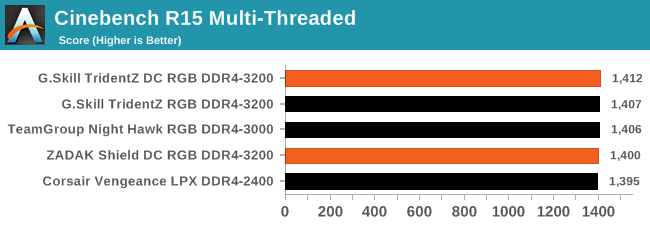
For power, we tested using Intel's Power Gadget tool, which has the hooks to test DDR4. The results show have two interesting scenarios. For power consumed per gigabyte, the new memory is fairly competitive:
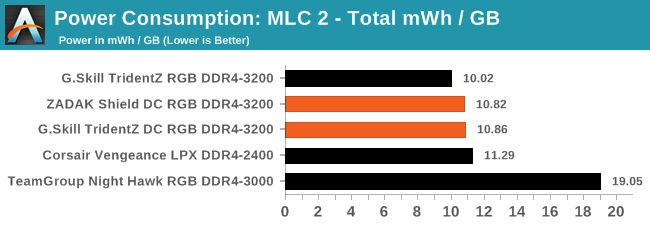
However, when we look at power per performance, in a benchmark where all the memory kits performed the same, then the value only comes from having the larger memory:
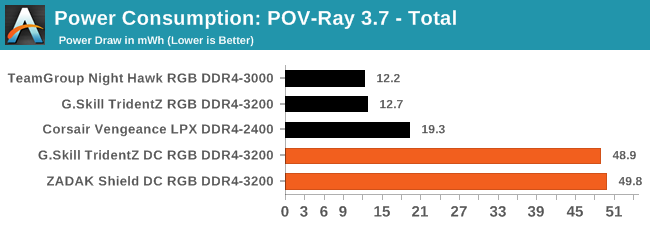
Compatibility
As mentioned, only three ASUS motherboards currently support this new double height DDR4 memory. It means these modules are going after a small market, or it will be up to system integrators to get the best deals for end-users when combining the right motherboard with the right memory. ASUS is keeping the details of how they enabled the new memory under wraps for now, likely seeing it as a competitive advantage in the aggressive motherboard market.
In the ASUS BIOSes, there's nothing much that gives them away, except that the BIOS shows that four memory slots are populated, despite the motherboard only having two available, confirming that each of these 32 GB memory modules are seen internally as 2x16GB modules.
Double Capacity, Double The Price
On the pricing front, this is down to the memory companies. G.Skill doesn't typically give official pricing for any of its kits, and the company states they like to be competitive per region on a weekly basis, which means they don't give 'global MSRPs' as they can change. The company did state however that the 2x32GB kits would be priced similar to its 4x16 GB kits. If this is right, the price for the G.Skill DC kits is expected to start from around $650 based on a 64 GB DDR4-3000 kit and closer to $1000 for DDR4-3200.
ZADAK unveiled its full MSRP pricing list to us. The baseline DDR4-2666 CL16 kit starts at $799, and the highest end DDR4-3600 kit finishes $1299.
Obviously, the benefits of the double height memory are focused on one key direction only: the need to have a total of 64 GB of memory in a particular form factor. Out of the three motherboards where this memory is actually qualified, only the Z390-I Gaming is a small form factor motherboard, so for users looking to optimize an SFF system, this would be the one to get. Larger systems rarely have this two memory slot limitation, and so the options for this memory are a lot larger, unless the user absolutely needs to use the Gene or the Apex motherboards from ASUS.


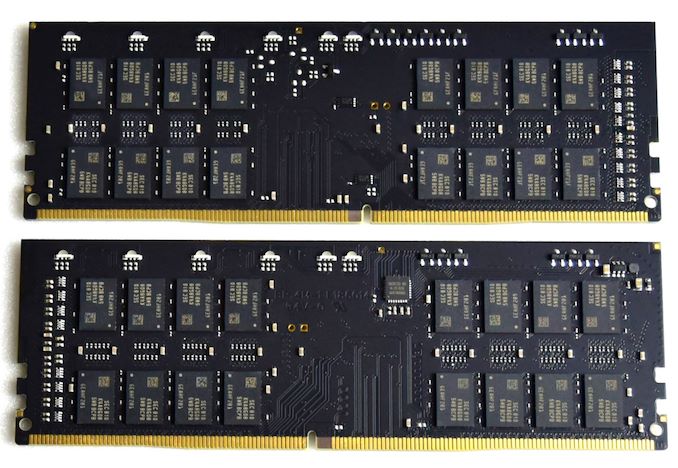

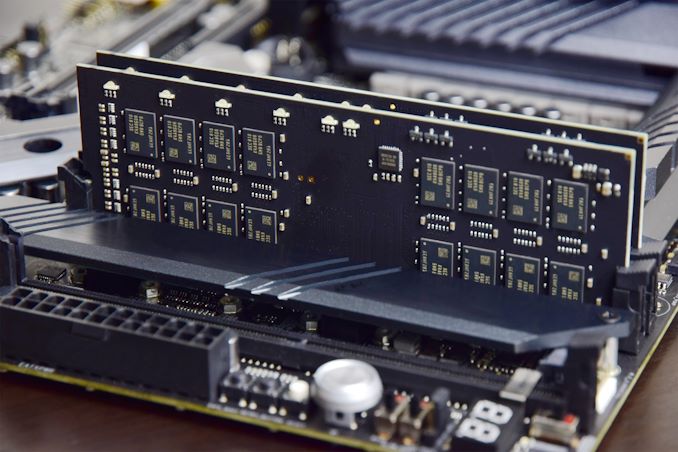








50 Comments
View All Comments
mickulty - Wednesday, January 23, 2019 - link
Really interesting article, thanks Gav and Ian!I'd love to see how a configuration using these DC sticks compares to 4x16GB on a 4-dimm T-topology board, especially in ability to hit higher speeds.
edzieba - Wednesday, January 23, 2019 - link
Presumably the "Two DIMMs One Channel"-on-a-board layout would preclude these being used in 4-slot consumer boards (which would require effectively 4 DIMMs per channel)? I can't think of any boards off the top of my head that support more than 2 DIMMs per channel without using FBDIMMs.Ej24 - Wednesday, January 23, 2019 - link
Intel has validated their 8th and 9th gen desktop cpu's to work with 128gb of memory so that would suggest its possible, it's just up to the motherboard manufacturer to implement it appropriately.Hul8 - Wednesday, January 23, 2019 - link
I believe that's using regular (not double) modules with 16x Samsung's new 16 Gb memory packages. You can still use 2 of those per channel on regular consumer motherboards.Ej24 - Wednesday, January 23, 2019 - link
https://www.anandtech.com/show/13473/intel-to-supp...schujj07 - Wednesday, January 23, 2019 - link
I wonder if something that this could be designed for servers using RDIMMS or LRDIMMS. Current cost of 64GB LRDIMMs is more than double that of 32GB RDIMMs. 128GB LRDIMMs are about 4x more expensive than 64GB LRDIMMs. Could be a nice way to increase RAM capacity there without breaking the bank.brakdoo - Wednesday, January 23, 2019 - link
128 GB and 256 GB DIMMs use TSV (sometimes called 3DS or 3D stacked in the server business) memory. That's why they are more expensive.Other than that: This approach doubles the rank. Typical servers already reach their "maximum rank" on each channel with regular sized memory.
mickulty - Wednesday, January 23, 2019 - link
It's pretty common for various forms of registered/buffered memory to use x4 width ICs rather than the standard x8, meaning you have 16 per rank rath than 8 per rank with the same capacity per IC. That acheives the same thing in terms of capacity.nathanddrews - Wednesday, January 23, 2019 - link
Certainly looks like the future of RAM, but like most things, I would wait for v3.0 before jumping in. There's bound to be more power savings, compatibility tweaks, and performance tweaks. When is DDR5 arriving?oddity1234 - Wednesday, January 23, 2019 - link
That's a bizarre existential predicament the sea slug is stuck in.